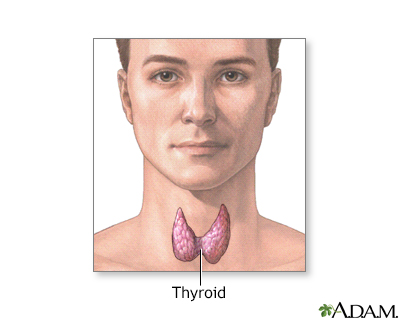Silent thyroiditis
Lymphocytic thyroiditis; Subacute lymphocytic thyroiditis; Painless thyroiditis; Postpartum thyroiditis; Thyroiditis - silent; Hyperthyroidism - silent thyroiditis
Silent thyroiditis is an immune reaction of the thyroid gland. The disorder can cause hyperthyroidism, followed by hypothyroidism.
The thyroid gland is located in the neck, just above where your collarbones meet in the middle.
Images

I Would Like to Learn About:
Causes
The cause of the disease is unknown. But it is related to an attack against the thyroid by the immune system. The disease affects women more often than men.
The disease can occur in women who have just had a baby. It can also be caused by medicines such as interferon and amiodarone, and some types of chemotherapy, which affect the immune system.
Symptoms
The earliest symptoms result from an overactive thyroid gland (hyperthyroidism). These symptoms may last for up to 3 months.
Symptoms are often mild, and may include:
- Fatigue, feeling weak
- Frequent bowel movements
- Heat intolerance
- Increased appetite
- Increased sweating
- Irregular menstrual periods
- Mood changes, such as irritability
- Muscle cramps
- Nervousness, restlessness
- Palpitations
- Weight loss
Later symptoms may be of an underactive thyroid (hypothyroidism), including:
- Fatigue
- Constipation
- Dry skin
- Irregular (or heavy) menstrual periods in women
- Mood changes
- Weight gain
- Cold intolerance
These symptoms can persist until the thyroid recovers normal function. The recovery of the thyroid can take many months in some people. Some people only notice the hypothyroid symptoms and do not have symptoms of hyperthyroidism to begin with.
Exams and Tests
Your health care provider will examine you and ask about your symptoms and medical history.
A physical examination may show:
- Enlarged thyroid gland that is not painful to the touch
- Rapid heart rate
- Shaking hands (tremor)
- Brisk reflexes
- Sweaty, warm skin
Tests that may be done include:
- Radioactive iodine uptake
- Thyroid hormones T3 (triiodothyronine) and T4 (thyroxine)
- TSH (thyroid stimulating hormone)
- Erythrocyte sedimentation rate (ESR)
- C-reactive protein (CRP)
Many providers now screen for thyroid disease before and after starting medicines that commonly cause this condition.
Treatment
Treatment is based on symptoms. Medicines called beta-blockers may be used to relieve rapid heart rate and excessive sweating.
Outlook (Prognosis)
Silent thyroiditis often goes away on its own within 1 year. The acute phase usually ends within 3 months.
Some people develop hypothyroidism over time. They need to be treated with a medicine that replaces thyroid hormone. Regular follow-ups with a provider are recommended.
The disease is not infectious. People cannot catch the disease from you. It also is not inherited within families like some other thyroid conditions.
When to Contact a Medical Professional
Contact your provider if you have symptoms of this condition.
Related Information
Chronic thyroiditis (Hashimoto disease)Hyperthyroidism
References
Brent GA, Weetman AP. Hypothyroidism and thyroiditis. In: Melmed S, Auchus RJ, Goldfine AB, Koenig RJ, Rosen CJ, eds. Williams Textbook of Endocrinology. 14th ed. Philadelphia, PA: Elsevier; 2020:chap 13.
Hollenberg A, Wiersinga WM. Hyperthyroid disorders. In: Melmed S, Auchus RJ, Goldfine AB, Koenig RJ, Rosen CJ, eds. Williams Textbook of Endocrinology. 14th ed. Philadelphia, PA: Elsevier; 2020:chap 12.
Pearce EN, Hollenberg AN. Thyroid. In: Goldman L, Cooney KA, eds. Goldman-Cecil Medicine. 27th ed. Philadelphia, PA: Elsevier; 2024:chap 207.
Ramos-Levi AM, Marazuela M. Thyroiditis. In: Robertson RP, ed. DeGroot's Endocrinology. 8th ed. Philadelphia, PA: Elsevier; 2023:chap 73.
Smith JR, Wassner AJ. Thyroiditis. In: Kliegman RM, St. Geme JW, Blum NJ, Shah SS, Tasker RC, Wilson KM, eds. Nelson Textbook of Pediatrics. 21st ed. Philadelphia, PA: Elsevier; 2020:chap 582.
BACK TO TOPReview Date: 2/28/2024
Reviewed By: Sandeep K. Dhaliwal, MD, board-certified in Diabetes, Endocrinology, and Metabolism, Springfield, VA. Also reviewed by David C. Dugdale, MD, Medical Director, Brenda Conaway, Editorial Director, and the A.D.A.M. Editorial team.

Health Content Provider
06/01/2025
|
A.D.A.M., Inc. is accredited by URAC, for Health Content Provider (www.urac.org). URAC's accreditation program is an independent audit to verify that A.D.A.M. follows rigorous standards of quality and accountability. A.D.A.M. is among the first to achieve this important distinction for online health information and services. Learn more about A.D.A.M.'s editorial policy, editorial process and privacy policy. A.D.A.M. is also a founding member of Hi-Ethics. This site complied with the HONcode standard for trustworthy health information from 1995 to 2022, after which HON (Health On the Net, a not-for-profit organization that promoted transparent and reliable health information online) was discontinued. |
The information provided herein should not be used during any medical emergency or for the diagnosis or treatment of any medical condition. A licensed medical professional should be consulted for diagnosis and treatment of any and all medical conditions. Links to other sites are provided for information only -- they do not constitute endorsements of those other sites. © 1997- 2025 A.D.A.M., a business unit of Ebix, Inc. Any duplication or distribution of the information contained herein is strictly prohibited.
